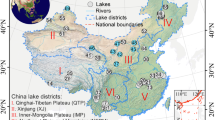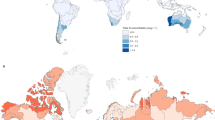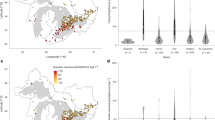Abstract
Domestic wastewater and agricultural activities are important sources of nutrient pollutants such as phosphorus and nitrogen. Upon reaching freshwater, these nutrients can lead to extensive growth of harmful algae, which results in eutrophication. Many Chinese lakes are subject to such eutrophication, especially in highly polluted areas, and as such, understanding nutrient fluxes to these lakes offers insights into the varying processes governing pollutant fluxes as well as lake water quality. Here we analyse water quality data, recorded between 2006 and 2014 in 862 freshwater lakes in four geographical regions of China, to assess the input of phosphorus from human activity. We find that improvements in sanitation of both rural and urban domestic wastewater have resulted in large-scale declines in lake phosphorus concentrations in the most populated parts of China. In more sparsely populated regions, diffuse sources such as aquaculture and livestock farming offset this decline. Anthropogenic deforestation and soil erosion may also offset decreases in point sources of pollution. In the light of these regional differences, we suggest that a spatially flexible set of policies for water quality control would be beneficial for the future health of Chinese lakes.
This is a preview of subscription content, access via your institution
Access options
Access Nature and 54 other Nature Portfolio journals
Get Nature+, our best-value online-access subscription
$29.99 / 30 days
cancel any time
Subscribe to this journal
Receive 12 print issues and online access
$259.00 per year
only $21.58 per issue
Buy this article
- Purchase on Springer Link
- Instant access to full article PDF
Prices may be subject to local taxes which are calculated during checkout




Similar content being viewed by others
References
Peñuelas, J., Sardans, J., Rivas-Ubach, A. & Janssens, I. A. The human-induced imbalance between C, N and P in Earth’s life system. Glob. Change Biol. 18, 3–6 (2012).
Peñuelas, J. et al. Human-induced nitrogen–phosphorus imbalances alter natural and managed ecosystems across the globe. Nat. Commun. 4, 2934 (2013).
Carpenter, S. R. Phosphorus control is critical to mitigating eutrophication. Proc. Natl Acad. Sci. USA 105, 11039–11040 (2008).
Stone, R. China aims to turn tide against toxic lake pollution. Science 333, 1210–1211 (2011).
Conley, D. J. et al. Controlling eutrophication: nitrogen and phosphorus. Science 123, 1014–1015 (2009).
Liu, X. et al. Intensification of phosphorus cycling in China since the 1600s. Proc. Natl Acad. Sci. USA 113, 2609–2614 (2016).
Smith, V. H. Eutrophication of freshwater and coastal marine ecosystems—a global problem. Environ. Sci. Poll. Res. 10, 126–139 (2003).
Schindler, D. W., Carpenter, S. R., Chapra, S. C., Hecky, R. E. & Orihel, D. M. Reducing phosphorus to Curb Lake eutrophication is a success. Environ. Sci. Technol. 50, 8923–8929 (2016).
Elser, J. J. et al. Global analysis of nitrogen and phosphorus limitation of primary producers in freshwater, marine and terrestrial ecosystems. Ecol. Lett. 10, 1124–1134 (2007).
Lewis, W. M. Jr, Wurtsbaugh, W. A. & Paerl, H. W. Rationale for control of anthropogenic nitrogen and phosphorus in inland waters. Environ. Sci. Technol. 45, 10030–10035 (2011).
Law of the People’s Republic of China on the Prevention and Control of Water Pollution (Standing Committee of the National People’s Congress, 2008).
National Environmental Protection 11th Five-Year and 12th Five-Year-Plan (Ministry of Environmental Protection of P. R. China, 2012).
China Environmental Statistical Yearbook, 2006–2014 (Ministry of Environmental Protection of P. R. China, 2006–2014).
Toilet Revolution (National Health and Family Planning Commission of P. R. China, 2015).
China Statistical Yearbook, 2006–2014 (National Bureau of Statistics of P. R. China, 2006–2014).
Azevedo, L. B., Henderson, A. D., Van, Z. R., Jolliet, O. & Huijbregts, M. A. Assessing the importance of spatial variability versus model choices in Life Cycle Impact Assessment: the case of freshwater eutrophication in Europe. Environ. Sci. Technol. 47, 13565–13570 (2013).
Helmes, R. J. K., Huijbregts, M. A. J., Henderson, A. D. & Jolliet, O. Spatially explicit fate factors of phosphorous emissions to freshwater at the global scale. Int. J. Life Cycle Assess. 17, 646–654 (2012).
Hellweg, S. & Milài Canals, L. Emerging approaches, challenges and opportunities in life cycle assessment. Science 344, 1109–1113 (2014).
Tao, S. L. et al. Rapid loss of lakes on the Mongolian Plateau. Proc. Natl Acad. Sci. USA 112, 2281–2286 (2015).
Wang, R. et al. Black carbon emissions in China from 1949 to 2050. Environ. Sci. Technol. 46, 7595–7603 (2012).
Zhang, Q. Q., Ying, G. G., Pan, C. G., Liu, Y. S. & Zhao, J. L. Comprehensive evaluation of antibiotics emission and fate in the river basins of China: source analysis, multimedia modeling, and linkage to bacterial resistance. Environ. Sci. Technol. 49, 6772–6782 (2015).
USGS Minerals Yearbook: Phosphate Rock (US Geological Survey, 1950–2013).
Zhang, H., Li, H. L. & Chen, Z. Analysis of land use dynamic change and its impact on the water environment in Yunnan Plateau Lake Area—a case study of the Dianchi Lake Drainage Area. Proc. Environ. Sci. 10, 2709–2717 (2011).
Stoddard, J. L. et al. Continental-scale increase in lake and stream phosphorus: are oligotrophic systems disappearing in the US? Environ. Sci. Technol. 50, 3409–3415 (2016).
Zhang, C. L., Liu, Y. & Qiao, H. J. An empirical study on the spatial distribution of the population, economy and water resources in Northeast China. Phys. Chem. Earth A/B/C 79–82, 93–99 (2015).
Water resources in Northeast China Project Group. Strategic concern to land and water resources allocation, Ecology and Environment Protection and Sustainable Development of Northeast China. Eng. Sci. 8, 1–24 (2006).
Jin, X. C. & Zhu, X. Trophic characteristics and changes of water bodies of the main lakes and reservoirs in China. Res. Environ. Sci. 4, 11–20 (1991).
You, G. C. et al. Measures and suggestions for development of Pinus sylvestris var. mongolica in Liaoning Province. Prot. For. Sci. Technol. 5, 69–71 (2012).
Kaňa, J., Tahovská, K. & Kopáček, J. Response of soil chemistry to forest dieback after bark beetle infestation. Biogeochemistry 113, 369–383 (2013).
Fang, H. Y. & Sun, L. Y. Modelling soil erosion and its response to the soil conservation measures in the black soil catchment, Northeastern China. Soil Till. Res. 165, 23–33 (2017).
Wang, R. et al. Significant contribution of combustion-related emissions to the atmospheric phosphorus budget. Nat. Geosci. 8, 48–54 (2015).
Goedkoop, M. J. et al. A life cycle impact assessment method which comprises harmonised category indicators at the midpoint and the endpoint level (2009) (Accessed 26 April 2016); http://www.lcia-recipe.net
European Environmental Agency. Waterbase -Lakes (2015) (Accessed 18 July 2016); http://www.eea.europa.eu/data-and-maps/data/waterbase-lakes-6
Jeppesen, E. et al. Lake responses to reduced nutrient loading-an analysis of contemporary long-term data from 35 case studies. Freshwat. Biol. 50, 1747–1771 (2005).
Carpenter, S. R. et al. Nonpoint pollution of surface waters with phosphorus and nitrogen. Ecol. Appl. 8, 559–568 (1998).
Paerl, H. W. et al. It takes two to tango: When and where dual nutrient (N & P) reductions are needed to protect lakes and downstream ecosystems. Environ. Sci. Technol. 50, 10805–10813 (2016).
Lewis, W. M. & Wurtsbaugh, W. A. Control of lacustrine phytoplankton by nutrients: erosion of the phosphorus paradigm. Int. Rev. Hydrobiol. 93, 446–465 (2008).
Xu, H. et al. Nitrogen and phosphorus inputs control phytoplankton growth in eutrophic Lake Taihu, China. Limnol. Oceanogr. 55, 420–432 (2010).
Paerl, H. W. et al. Controlling harmful cyanobacterial blooms in a hyper-eutrophic lake (Lake Taihu, China): the need for a dual nutrient (N & P) management strategy. Wat. Res. 45, 1973–1983 (2011).
Paerl, H. W. et al. Nutrient limitation dynamics examined on a multi-annual scale in Lake Taihu, China: implications for controlling eutrophication and harmful algal blooms. J. Freshwat. Ecol. 30, 5–24 (2015).
Technical Specifications Requirements for Monitoring of Surface Water and Waste Water (Ministry of Environmental Protection of P. R. China, 2002).
Environmental Quality Standard for Surface Water, China (Ministry of Environmental Protection of P. R. China, 2002).
Liu, Y., Villalba, G., Ayres, R. U. & Schroder, H. Global phosphorus flows and environmental impacts from a consumption perspective. J. Ind. Ecol. 12, 229–247 (2008).
Yuan, Z. W., Wu, H. J., He, X. F. & Liu, X. A bottom-up model for quantifying anthropogenic phosphorus cycles in watersheds. J. Clean. Prod. 84, 502–508 (2014).
Huijbregts, M. A. J., Hellweg, S. & Hertwich, E. Do we need a paradigm shift in life cycle impact assessment? Environ. Sci. Technol. 45, 3833–3834 (2011).
Burnham, K. P. & Anderson, D. R. Model-Selection and Multi-Model Inference: A Practical Information-Theoretic Approach (Springer, 2002).
Acknowledgements
We greatly appreciate the useful comments in the pre-reviews by D. E. Armstrong, College of Engineering, University of Wisconsin-Madison, USA, and P. Whitehead, School of Geography and the Environment, University of Oxford, UK. We also appreciate the help from R. F. Wright, Norwegian Institute for Water Research, in the further improvement of the manuscript in the revision processes. D. Whitehead, Asian-English Language Services, UK, helped in the polishing of the language.
Author information
Authors and Affiliations
Contributions
Y.T., W.Z., X.W., Y.Z. and Y.L. conceived the study. J.L. and H.L. performed the calculation of eutrophication potential. Y.T., X.L., X.B. and Y.L. performed the calculation of the phosphorus discharges. Y.T., Y.L., R.-M.C., T.L., W.H. and Q.Z. wrote the paper.
Corresponding author
Ethics declarations
Competing interests
The authors declare no competing financial interests.
Supplementary information
Supplementary Information
Supplementary Information (PDF 1138 kb)
Supplementary Information
Supplementary Information (XLSX 828 kb)
Supplementary Information
Supplementary Information (XLSX 22 kb)
Supplementary Information
Supplementary Information (XLSX 144 kb)
Rights and permissions
About this article
Cite this article
Tong, Y., Zhang, W., Wang, X. et al. Decline in Chinese lake phosphorus concentration accompanied by shift in sources since 2006. Nature Geosci 10, 507–511 (2017). https://doi.org/10.1038/ngeo2967
Received:
Accepted:
Published:
Issue Date:
DOI: https://doi.org/10.1038/ngeo2967
This article is cited by
-
High resolution spatiotemporal modeling of long term anthropogenic nutrient discharge in China
Scientific Data (2024)
-
Predicting Effects of Non-Point Source Pollution Emission Control Schemes Based on VMD-BiLSTM and MIKE21
Environmental Modeling & Assessment (2024)
-
Changes in China’s river water quality since 1980: management implications from sustainable development
npj Clean Water (2023)
-
Revealing the hidden burden for lake management: the sediment phosphorus storage pools in Eastern Plain Lake Zone, China
Environmental Science and Pollution Research (2023)
-
Validity, applicability, and universality of fractal scaling laws for lakes in China
Aquatic Sciences (2023)



